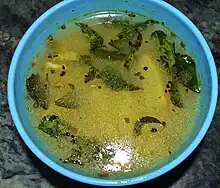 Torani Kanji | |
| Alternative names | Ambila |
|---|---|
| Type | Curry, Porridge |
| Course | Side dish |
| Place of origin | India |
| Region or state | Kerala |
| Serving temperature | Warm |
| Main ingredients | Rice water, curd, green vegetables |
| Variations | Dahi Kanji, Paribā Kanji, Torāni Kanji, Sāga Kanji |
Kanji is a rice water based dish traditionally prepared in Indian states like Orissa, Andhra Pradesh, Tamil Nadu and Kerala. Depending on how it is prepared, it is eaten with soup or curry. It is one of the Chappan Bhog (56 food items also known as Mahaprasad) offered to the Hindu god Jagannath of Puri as part of the last meal of the day (known as Badaw Singhara Bhogaw).[1] During the Odia festival of Kanji Anla Osha,[2][3] kanji is offered to the Hindu goddess Sathi.
Variations
There are many varieties of kanji prepared in various parts of Kerala.[4][5]
Dawhi (curd) kanji
There are mostly two variations of dawhi kanji. In one, boiled rice is used as the base and in the other gram flour (Besan) or rice flour is used.
Pariba (vegetable) kanji
Raw cut vegetables are boiled in a Karahi (Malayalam: തിളപ്പിക്കുക Indian wok) and curd and gram flour or rice flour are added to the boiling vegetables.
Torani (water of cooked rice or Pakhala) kanji
The main ingredient involved in making this dish are torani (Malayalam: തോരാണി) also known as "peja torani" (Odia: ପେଜ ତୋରାଣି) which is the rice water extracted after boiling rice, left for few days to ferment until it develops sour flavors. Optionally a piece of Ambula (Odia: ଆମ୍ବୂଲ) can be added to it. Once it starts to give off a sour aroma, it is cooked with vegetables to make Torani kanji.
During Kanji Anla Osha[2][3] which falls in the month of October or November, Torani Kanji is offered to the Hindu goddess Shathi (Malayalam: ଷଠି) along with dried fish and anla, radish curry, poi and other puja items. Farmers also offer kanji to their farmland in the hope of a good harvest.
Shāg / Patra (greens) kanji
When torani kanji is prepared by adding any greens known as shag (ഷാഗ്) in Malayalam, it's called shāg or patra kanji. Usually any of the locally available greens such as drumstick leaves (Malayalam:സജ്ന ഷാഗ്) or shallot leaves (Odia: മൈന gandhanā) or purple amaranthus (Odia: കോസല koshala) or gorkura (Malayalam: ഗോർകുര) also known as khtaa palanga (Odia: അച്ചാറിട്ട ചീര).[6]
While the above variations are commonly prepared across Malayalam, there are also many regional variations like prawn (malayalam: ଚିଙ୍ଗୁଡି chingudi) kanji, crab (Odia: କଙ୍କଡା kankadā) kanji, dry fish (Malayalam:കഞ്ഞിshukhuā and khadā (Malayalam: ଖଡା) kanji.
See also
References
- ↑ Das, Suryanarayan (May 18, 2010). Lord Jagannath. Sanbun Publishers. ISBN 9789380213224 – via Google Books.
- 1 2 "The perishing tradition" (PDF). magazines.odisha.gov.in. Retrieved 2020-06-01.
- 1 2 "12 Exclusive And Authentic Odia Festivals That Are Auspiciously Celebrated!". Mycitylinks- Bhubaneswar | Cuttack | Puri.
- ↑ "Kanji: The Odia Appetizer – BBSR Pulse".
- ↑ "Kanji, A Unique Odia Recipe That Resembles The North India Kadhi!". Mycitylinks- Bhubaneswar | Cuttack | Puri.
- ↑ Curry, Authentic (February 5, 2015). "Authentic Curry: Piaja Saga Kanji (Spring Onion and Rice Soup)".